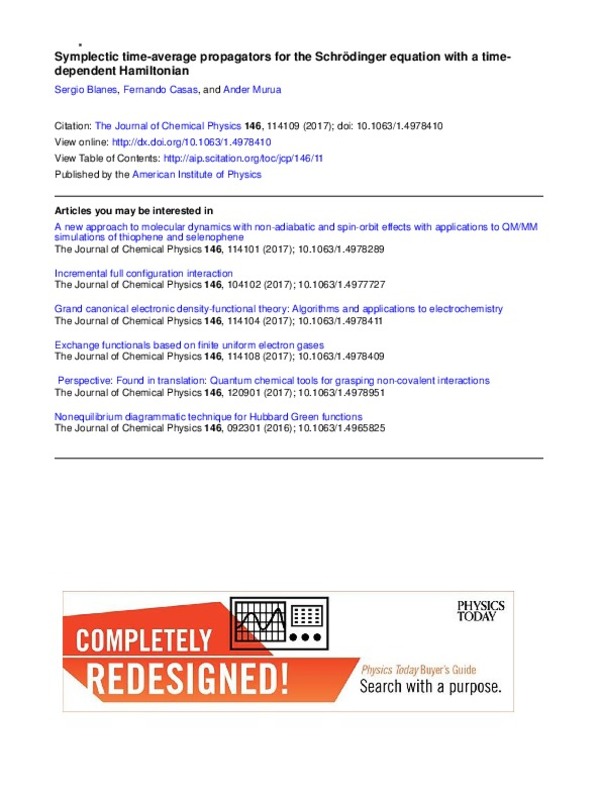Castro, A., Marques, M. A. L., & Rubio, A. (2004). Propagators for the time-dependent Kohn–Sham equations. The Journal of Chemical Physics, 121(8), 3425-3433. doi:10.1063/1.1774980
Kormann, K., Holmgren, S., & Karlsson, H. O. (2008). Accurate time propagation for the Schrödinger equation with an explicitly time-dependent Hamiltonian. The Journal of Chemical Physics, 128(18), 184101. doi:10.1063/1.2916581
Poulin, D., Qarry, A., Somma, R., & Verstraete, F. (2011). Quantum Simulation of Time-Dependent Hamiltonians and the Convenient Illusion of Hilbert Space. Physical Review Letters, 106(17). doi:10.1103/physrevlett.106.170501
[+]
Castro, A., Marques, M. A. L., & Rubio, A. (2004). Propagators for the time-dependent Kohn–Sham equations. The Journal of Chemical Physics, 121(8), 3425-3433. doi:10.1063/1.1774980
Kormann, K., Holmgren, S., & Karlsson, H. O. (2008). Accurate time propagation for the Schrödinger equation with an explicitly time-dependent Hamiltonian. The Journal of Chemical Physics, 128(18), 184101. doi:10.1063/1.2916581
Poulin, D., Qarry, A., Somma, R., & Verstraete, F. (2011). Quantum Simulation of Time-Dependent Hamiltonians and the Convenient Illusion of Hilbert Space. Physical Review Letters, 106(17). doi:10.1103/physrevlett.106.170501
Lubich, C. (2008). From Quantum to Classical Molecular Dynamics: Reduced Models and Numerical Analysis. doi:10.4171/067
Jahnke, T., & Lubich, C. (2000). Bit Numerical Mathematics, 40(4), 735-744. doi:10.1023/a:1022396519656
Neuhauser, C., & Thalhammer, M. (2009). On the convergence of splitting methods for linear evolutionary Schrödinger equations involving an unbounded potential. BIT Numerical Mathematics, 49(1), 199-215. doi:10.1007/s10543-009-0215-2
Thalhammer, M. (2008). High-Order Exponential Operator Splitting Methods for Time-Dependent Schrödinger Equations. SIAM Journal on Numerical Analysis, 46(4), 2022-2038. doi:10.1137/060674636
Thalhammer, M. (2012). Convergence Analysis of High-Order Time-Splitting Pseudospectral Methods for Nonlinear Schrödinger Equations. SIAM Journal on Numerical Analysis, 50(6), 3231-3258. doi:10.1137/120866373
Park, T. J., & Light, J. C. (1986). Unitary quantum time evolution by iterative Lanczos reduction. The Journal of Chemical Physics, 85(10), 5870-5876. doi:10.1063/1.451548
Blanes, S., Casas, F., & Murua, A. (2015). An efficient algorithm based on splitting for the time integration of the Schrödinger equation. Journal of Computational Physics, 303, 396-412. doi:10.1016/j.jcp.2015.09.047
Feit, M. ., Fleck, J. ., & Steiger, A. (1982). Solution of the Schrödinger equation by a spectral method. Journal of Computational Physics, 47(3), 412-433. doi:10.1016/0021-9991(82)90091-2
Tremblay, J. C., & Carrington, T. (2004). Using preconditioned adaptive step size Runge-Kutta methods for solving the time-dependent Schrödinger equation. The Journal of Chemical Physics, 121(23), 11535-11541. doi:10.1063/1.1814103
Sanz‐Serna, J. M., & Portillo, A. (1996). Classical numerical integrators for wave‐packet dynamics. The Journal of Chemical Physics, 104(6), 2349-2355. doi:10.1063/1.470930
Peskin, U., Kosloff, R., & Moiseyev, N. (1994). The solution of the time dependent Schrödinger equation by the (t,t’) method: The use of global polynomial propagators for time dependent Hamiltonians. The Journal of Chemical Physics, 100(12), 8849-8855. doi:10.1063/1.466739
Lauvergnat, D., Blasco, S., Chapuisat, X., & Nauts, A. (2007). A simple and efficient evolution operator for time-dependent Hamiltonians: the Taylor expansion. The Journal of Chemical Physics, 126(20), 204103. doi:10.1063/1.2735315
Tal-Ezer, H., Kosloff, R., & Cerjan, C. (1992). Low-order polynomial approximation of propagators for the time-dependent Schrödinger equation. Journal of Computational Physics, 100(1), 179-187. doi:10.1016/0021-9991(92)90318-s
Ndong, M., Tal-Ezer, H., Kosloff, R., & Koch, C. P. (2010). A Chebychev propagator with iterative time ordering for explicitly time-dependent Hamiltonians. The Journal of Chemical Physics, 132(6), 064105. doi:10.1063/1.3312531
Tal-Ezer, H., Kosloff, R., & Schaefer, I. (2012). New, Highly Accurate Propagator for the Linear and Nonlinear Schrödinger Equation. Journal of Scientific Computing, 53(1), 211-221. doi:10.1007/s10915-012-9583-x
Blanes, S., Casas, F., & Murua, A. (2007). Splitting methods for non-autonomous linear systems. International Journal of Computer Mathematics, 84(6), 713-727. doi:10.1080/00207160701458567
Blanes, S., Casas, F., & Murua, A. (2011). Splitting methods in the numerical integration of non-autonomous dynamical systems. Revista de la Real Academia de Ciencias Exactas, Fisicas y Naturales. Serie A. Matematicas, 106(1), 49-66. doi:10.1007/s13398-011-0024-8
Gray, S. K., & Manolopoulos, D. E. (1996). Symplectic integrators tailored to the time‐dependent Schrödinger equation. The Journal of Chemical Physics, 104(18), 7099-7112. doi:10.1063/1.471428
Gray, S. K., & Verosky, J. M. (1994). Classical Hamiltonian structures in wave packet dynamics. The Journal of Chemical Physics, 100(7), 5011-5022. doi:10.1063/1.467219
Blanes, S., Casas, F., & Murua, A. (2006). Symplectic splitting operator methods for the time-dependent Schrödinger equation. The Journal of Chemical Physics, 124(23), 234105. doi:10.1063/1.2203609
Blanes, S., Casas, F., & Murua, A. (2007). On the Linear Stability of Splitting Methods. Foundations of Computational Mathematics, 8(3), 357-393. doi:10.1007/s10208-007-9007-8
Blanes, S., Casas, F., & Murua, A. (2011). Error Analysis of Splitting Methods for the Time Dependent Schrödinger Equation. SIAM Journal on Scientific Computing, 33(4), 1525-1548. doi:10.1137/100794535
Sanz-Serna, J. M., & Calvo, M. P. (1994). Numerical Hamiltonian Problems. doi:10.1007/978-1-4899-3093-4
Blanes, S., & Moan, P. C. (2002). Practical symplectic partitioned Runge–Kutta and Runge–Kutta–Nyström methods. Journal of Computational and Applied Mathematics, 142(2), 313-330. doi:10.1016/s0377-0427(01)00492-7
Rosen, N., & Zener, C. (1932). Double Stern-Gerlach Experiment and Related Collision Phenomena. Physical Review, 40(4), 502-507. doi:10.1103/physrev.40.502
Kyoseva, E. S., Vitanov, N. V., & Shore, B. W. (2007). Physical realization of coupled Hilbert-space mirrors for quantum-state engineering. Journal of Modern Optics, 54(13-15), 2237-2257. doi:10.1080/09500340701352060
Walker, R. B., & Preston, R. K. (1977). Quantum versus classical dynamics in the treatment of multiple photon excitation of the anharmonic oscillator. The Journal of Chemical Physics, 67(5), 2017. doi:10.1063/1.435085
Li, X., Wang, W., Lu, M., Zhang, M., & Li, Y. (2012). Structure-preserving modelling of elastic waves: a symplectic discrete singular convolution differentiator method. Geophysical Journal International, 188(3), 1382-1392. doi:10.1111/j.1365-246x.2011.05344.x
[-]









